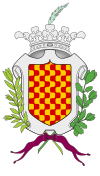Tarragona
| Tarragona | |||
|---|---|---|---|
| Municipality | |||

View of Tarragona
|
|||
|
|||
| Location of Tarragona within Catalonia | |||
| Coordinates: 41°06′56.51″N 1°14′58.54″E / 41.1156972°N 1.2495944°ECoordinates: 41°06′56.51″N 1°14′58.54″E / 41.1156972°N 1.2495944°E | |||
| Country | Spain | ||
| Autonomous Community | Catalonia | ||
| Province | Tarragona | ||
| Comarca | Tarragonès | ||
| Founded | 5th century BC | ||
| Government | |||
| • Mayor | Josep Fèlix Ballesteros Casanaova (2015) (Spanish Socialist Workers' Party) | ||
| Area | |||
| • Total | 57.9 km2 (22.4 sq mi) | ||
| Elevation (AMSL) | 68 m (223 ft) | ||
| Population (2015) | |||
| • Total | 131,255 | ||
| • Density | 2,300/km2 (5,900/sq mi) | ||
| Postal code | 43001 - 43008 | ||
| Area code(s) | +34 (E) + 977 (T) | ||
| Website | www |
||
Tarragona (English /ˌtɑːrəˈɡoʊnə/, Catalan: [tərəˈɣonə], Spanish: [taraˈɣona]; Phoenician: Tarqon; Latin: Tarraco) is a port city located in northeast Spain on the Costa Daurada by the Mediterranean Sea. It is the capital of the Province of Tarragona, and part of Tarragonès and Catalonia. Geographically, it is bordered on the north by the Province of Barcelona and the Province of Lleida. The city has a population of 132,199 (2014).
One Catalan legend holds that it was named for Tarraho, eldest son of Tubal in c. 2407 BC; another (derived from Strabo and Megasthenes) attributes the name to 'Tearcon the Ethiopian', a 7th-century BC pharaoh who supposedly campaigned in Spain. The real founding date of Tarragona is unknown.
The city may have begun as an Iberic town called Kesse or Kosse, named for the Iberic tribe of the region, the Cossetans, though the identification of Tarragona with Kesse is not certain.William Smith suggests that the city was probably founded by the Phoenicians, who called it Tarchon, which, according to Samuel Bochart, means a citadel. This name was probably derived from its situation on a high rock, between 75–90 m (250–300 ft) above the sea; whence we find it characterised as arce potens Tarraco. It was seated on the river Sulcis or Tulcis (modern Francolí), on a bay of the Mare Internum (Mediterranean), between the Pyrenees and the river Iberus (modern Ebro).Livy mentions a portus Tarraconis; and according to Eratosthenes it had a naval station or roads (Ναύσταθμον); but Artemidorus Ephesius says with more probability that it had none, and scarcely even an anchoring place; and Strabo himself calls it ἀλίμενος. This better reflects its present condition; for though a mole was constructed in the 15th century with the materials of the ancient amphitheatre, and another subsequently by an Irishman named John Smith Sinnot, it still affords but little protection for shipping.
...
Wikipedia



